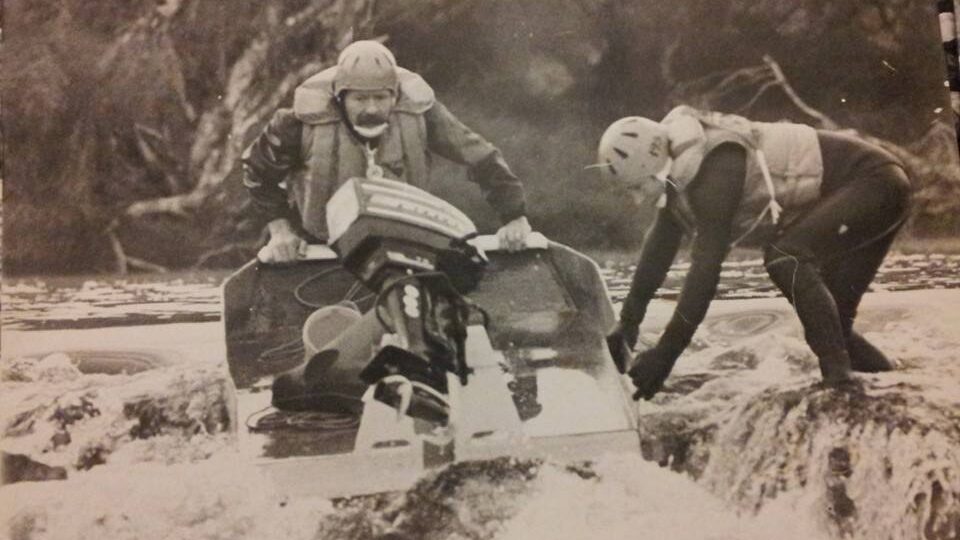Club History
The Dinghy Touring Club was formed in 1977 from a loose grouping of Avon Descent competitors in the southern suburbs of Perth (WA), a larger group of racers in the northern suburbs and persons already involved in the “Loyal Swan Bathtub Society”.
Initially, the only races were the Avon Descent (organised by the Northam Tourist Bureau) and the Blackwood Classic 250, started by the Whitney family and directed by David Whitney for the first ten years. Gradually other races were developed, mostly as a result of exploratory trips on unknown rivers and visits to regional centers.
Kim Epton put together the Rottnest Race in 1979 and the Upper Avon Challenge a few years later. Paul Tregurtha developed the Harvey Handicap and the Marina to Marina in 1983. This was the year the name of the Dinghy Touring Club was changed to the Power Dinghy Racing Club.
The next year Paul introduced the Serpentine Sprint and the Moore River Sprint.
Bruce and Barbara Wilson started the Frederickstown Cup in 1986. It proved a very popular event for many years but succumbed to bureaucracy in 1997. The Capel Classic organised and run by Paul Tregurtha and Kim Epton was run just once, falling victim to uninformed greenies.
Following the success of the Rottnest Race, other ocean races made their appearance on the calendar. These included the Round Rotto Rally, Marina to Marina and the Blue Water Classic. They proved to be too ruinous to boat and body and gradually died out.
In late 1985 the Power Dinghy Racing Club was disbanded and the Australian Power Dinghy Racing Association was formed. The APDRA assumed the control of all events previously conducted by the PDRC. The Association year was changed from July-June to May-April.
After ten years as Director of the Blackwood Classic 250 David Whitney bowed out. The race was run by the Blackwood River Sports Club for the next few years.
Many of the earlier races were abandoned for various reasons (inability to get official permission, lack of interest) and other races took their place. Paul Tregurtha started the Nannup Cup and the Blackwood River Sports Club started the Sunnyside Down. The Peel Inlet Derby was held in 1985 and ten years later was resurrected as the Peel Pursuit.
The name of the Club reverted to the Power Dinghy Racing Club (Inc) in 1990. An icon of the sport, Mario Ambrosino, was tragically killed in a traffic crash in April 1990 and, in his memory, the award for the best attendance at Club events and functions was renamed the “Mario Ambrosino Best Member Award”.
Development of races continued. Arthur Fairhurst started the Spitpost Marathon (now known as the Swan Marathon), and Peter Street and Keith Brooker inaugurated the Enduro (now the Burswood Enduro). Various circuit races were run at different country locations, notably the Northam Regatta, organised by Neville Watson.
River expeditions were conducted all over Australia from 1981, mainly organised by Kim Epton. It’s a fact that all power dinghy races started from somebody doing an “expedition” along the river to ascertain the feasibility of a race.
The introduction in 1994 of the 10hp Sports Class (initially called Class 1) had a major effect on racing. Competitors who were somewhat heavier than the “jockeys” were now able to compete more effectively. The introduction of “rubberised” gearboxes was another innovation that had a major effect on the sport. Instead of a slight error or miscalculation meaning a smashed gearbox (usually causing withdrawal from the race and, later, unplanned expenditure) rubberised boxes kept many people racing and reduced their cost to do it.
The Club’s newest river race is The River Race, held on the upper Blackwood River since 1998, and scheduled midway between the Avon Descent and the Blackwood Classic 250.
The Club now conducts river races, distance races and circuit races. It has a full calendar of social functions and runs Events for Rookies, Juniors and Seniors.
An exciting development in 2003 was the introduction of the Solo Class. Not without its critics, this Class looks set to re-vitalise the sport, re-interest past competitors and provide an exciting form of racing.
Be sure to have a read of our newsletter archive here. It’s a great look into the past of the Power Dinghy Racing Club.

